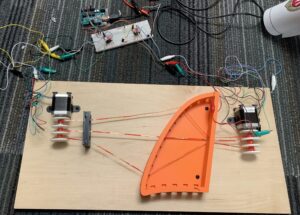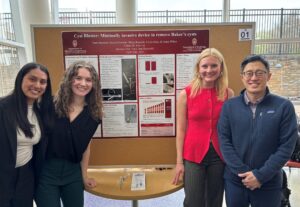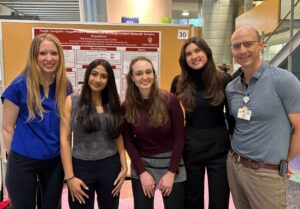For two decades, University of Wisconsin Department of Radiology faculty members and biomedical engineering undergraduates have taken great strides in solving clinical radiology challenges through the Biomedical Engineering (BME) Design program. This semester, Ken Lee, MD, MBA; Andrew Ross, MD, MPH; and Matthew Smith, MD, PhD served as clients for the program.

The BME Design program fosters interdisciplinary collaboration by pairing faculty members who serve as ‘clients’ with a team of BME students. Over the course of the semester, the students work to develop solutions for the clinical challenge their clients present. This work regularly leads to real results, including over 30 patent disclosures, 24 industry-sponsored projects, and three companies formed in the past three years alone.
Timothy Szczykutowicz, PhD participated nearly every semester in the past decade and possesses a deep appreciation for the program. His work with BME undergraduates has resulted in eight papers and a patent, as well as meaningful, lasting mentor-mentee relationships. In some cases, students have even taken such an interest in the project that they’ve gone on to work with Dr. Szczykutowicz in his lab.
He shared that one of his favorite aspects is the end-of-semester symposium. “The event has dozens of teams presenting all the very cool research going on at UW–Madison. I love seeing not only what other research labs and professors are up to, but what the BME students create. Listening to them explain how they figured something out, and seeing something that the students built that you can hold in your hand is really rewarding.”

Dr. Lee worked with two groups; one focused on developing a minimally invasive tool to remove baker cysts, and another developing a wearable device to measure muscle mass.
He initially pitched the ‘Cyst Blaster’ in fall 2023 and has continued to work with students to refine the product each semester since. The group designed a prototype that aims to provide a treatment that completely removes Baker Cysts, which have a high rate of reoccurrence. They are already seeing great progress in this effort, winning the 2025 Spring Student Choice Award as well as receiving an honorable mention for the Tong Biomedical Design Award.
Dr. Lee highly recommends the program to colleagues that are faced with a recurring clinical problem. “It’s really fun and rewarding to work with motivated undergraduate students who want to help solve a clinical problem. The interdisciplinary collaboration leads to solutions you may not have considered, and the time commitment is only about an hour a week for the semester; so it’s incredibly worthwhile to participate.”

Dr. Ross decided to submit his idea for a project after learning about the program from Dr. Lee. Not knowing what to expect as a first-time participant, he was interested in learning about the logistics and process for developing a medical device. Over the course of the semester, Dr. Ross worked with his team to create a prototype to better control the needle during complex injections, such as fluoro-guided cervical spine injections.
“The students were very enthusiastic and keen to understand the clinical issues surrounding the device we were working on,” Dr. Ross explained. “They came to shadow procedures, gave me weekly progress updates, and had creative approaches to solving the problem.” Dr. Ross looks forward to continuing to refine the product in coming semesters and potentially working with other groups to overcome additional clinical challenges.

While this past semester marked his first experience as a client, it wasn’t Dr. Smith’s first time participating in the program. During his time as an undergraduate at UW–Madison, he worked on several projects as a student engineer; and even worked with radiology faculty members Aaron Field, MD, PhD and Victor Haughton, MD. Describing this full-circle moment, Dr. Smith shared “It’s a privilege to help train and guide the next generation. They have so much potential, and these engineering students can improve the world with the right direction and encouragement. Undergraduate engineering held some of the best times of my life, and it’s been incredibly meaningful to be involved with students during this time in their lives.”
Dr. Smith’s team built a phantom to replicate blood flow in the lungs. While phantoms typically have a continuous constant flow, blood flow through the lungs is pulsatile. To more accurately represent the pulsatile flow, the students created a phantom that replicates the dynamic blood flow through the lungs. The phantom is used with x-ray pulsatility index (XPI) to create time of arrival maps.
The Department of Radiology has a rich history in participating in the BME Design Project program, and a bright future in new and continued collaborative efforts to create devices that will have a positive impact in the medical field.